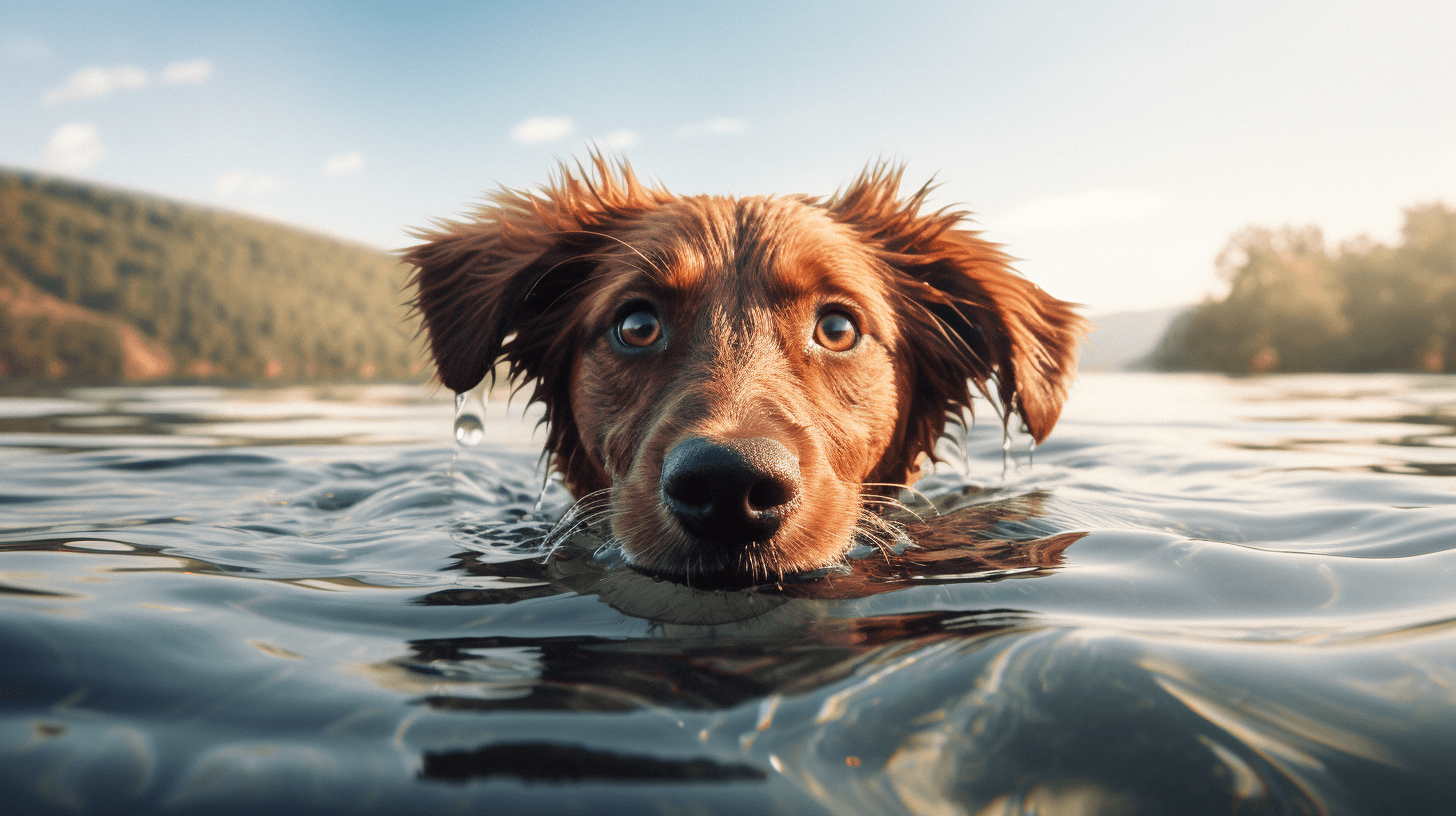Teach a Nervous Dog How to Swim: Overcoming a Dog’s Fear of Water
Helping Your Dog Face its fear of Water
Dogs can be scared of water for a variety of reasons, and understanding these fears is key to helping them become comfortable with swimming or even having a bath. Here’s a brief look at why dogs might fear water and how you can help them learn to swim:
Reasons Why Dogs May Fear Water
- Lack of Early Exposure: Dogs not exposed to water at a young age may be apprehensive simply because it’s unfamiliar.
- Negative Experiences: A previous negative experience with water (like being forced into water, or a near-drowning incident) can lead to fear.
- Sensory Overload: The sensation of water can be overwhelming for some dogs, especially if it involves loud noises like waves or splashing.
- Breed Disposition: Some breeds are less inclined towards water than others. Breeds not traditionally water-oriented may have a natural aversion to swimming.

Certain dog breeds are less inclined to enjoy water or swimming due to their physical characteristics, historical breeding purposes, or temperament. Here are some examples of such breeds:
- Basset Hound: Bred for hunting on land, their heavy build and short legs make swimming difficult and less enjoyable for them.
- Bulldog (English and French): Bulldogs often struggle with swimming due to their brachycephalic (short-nosed) faces, which make breathing more challenging, especially during physical exertion like swimming.
- Pug: Similar to Bulldogs, Pugs are also brachycephalic and can have difficulty breathing while swimming. Their compact body shape isn’t conducive to swimming.
- Dachshund: Their long bodies and short legs are not ideal for swimming. Dachshunds were bred for burrowing and hunting small game on land, not for water activities.
- Boxer: Despite being a strong and energetic breed, Boxers are not naturally adept swimmers. Their muscular build and brachycephalic face make swimming more challenging.
- Shih Tzu: Originally bred as companion dogs, Shih Tzus often don’t take to water. Their long coats can become heavy when wet, making swimming difficult.
- Chihuahua: Small in size and often not fond of water, Chihuahuas may be averse to swimming.
- Yorkshire Terrier: Their small size and preference for staying dry often make Yorkies less enthusiastic about swimming.
- Pekingese: Bred as a lap dog, the Pekingese has a physique that is not well-suited for swimming, and they often show little interest in water activities.
- Maltese: While they can swim, many Maltese dogs are not fond of the water. Their long, flowing coats can weigh them down when wet.
It’s important to remember that individual dogs within any breed can have their unique preferences. Some dogs from these breeds might enjoy water, while others will avoid it. Always observe your dog’s behaviour and comfort level around water and never force them to swim if they’re uncomfortable or scared.
Certain dog breeds are natural swimmers, often due to their physical characteristics, historical breeding purposes, or temperament that make them well-suited for water. Here are some examples of such breeds and the reasons behind their affinity for swimming:
- Labrador Retriever: Bred originally as a fishing and waterfowl hunting dog, Labs have water-resistant coats, webbed feet, and a strong, otter-like tail, all of which make them excellent swimmers.
- Golden Retriever: Similar to Labs, Golden Retrievers were also bred for retrieving waterfowl. They have a water-repellent coat and a love for water, making them natural swimmers.
- Portuguese Water Dog: As their name suggests, these dogs were bred to help fishermen by herding fish into nets, retrieving lost gear, and acting as couriers from ship to shore. They have webbed feet and a muscular build, ideal for swimming.
- Newfoundland: Known for their incredible swimming and water rescue abilities, Newfoundlands have a thick, water-resistant coat, webbed feet, and a powerful build. They were originally bred to help haul nets for fishermen and rescue people at risk of drowning.
- Chesapeake Bay Retriever: Bred for waterfowl hunting in the icy waters of Chesapeake Bay, these dogs have a dense, oily coat that provides excellent insulation and water resistance.
- English Setter: These dogs are known to be good swimmers. They were originally bred for bird setting and retrieving, which often involved water work.
- Spanish Water Dog: As a herding breed, they were also used for retrieving game from water. Their curly, woolly coat is naturally water-repellent.
- Irish Water Spaniel: One of the oldest spaniel breeds, they have a water-resistant coat and strong swimming abilities, historically used for retrieving waterfowl.
- Standard Poodle: Despite their fancy haircuts, Standard Poodles are excellent swimmers. They were originally bred as water retrievers, and their coat helps to protect vital body parts from cold water.
- Otterhound: Bred for hunting otters in water (now outlawed), Otterhounds have a rough, double coat and webbed feet, making them skilled swimmers.
These breeds often share common traits that make them good swimmers, such as water-resistant coats, webbed feet, and strong, well-muscled builds. Additionally, many of these breeds have a natural affinity for water and enjoy swimming, both as a form of exercise and play. However, even within these breeds, individual dogs may have varying degrees of interest in water activities.
How to Teach a Dog to Swim

- Start Slowly: Begin by introducing your dog to shallow water in a calm environment. A shallow paddling pool or a quiet section of a shallow lake or river can be good starting points.
- Positive Reinforcement: Use treats, toys, and lots of praise to create positive associations with water. Never force your dog into the water, as this can reinforce fear.
- Use a Dog Life Vest: A life vest for dogs can help them feel more secure and buoyant in the water. Make sure it fits well and allows for comfortable movement.
- Lead by Example: If you’re comfortable in the water, lead by example. Go into the water and encourage your dog to follow. Dogs often feel more confident when they see their owners or other dogs enjoying the water.
- Gradual Deepening: Gradually increase the depth of water as your dog becomes more comfortable. Always supervise and stay close to your dog during this process.
- Keep Sessions Short: Initially, keep the swimming sessions short to avoid overwhelming your dog. Gradually increase the time as they become more comfortable.
- Warm Water: Some dogs prefer warmer water, so try to introduce them to swimming in a warmer environment if possible.
- Consistency and Patience: Regular, gentle exposure is key. Be patient and consistent with your efforts. It might take time for your dog to fully embrace swimming.
- Professional Help: If your dog is extremely fearful, consider seeking help from a professional dog trainer who has experience with water training.
Remember, not all dogs are natural swimmers, and some may never be completely comfortable in water. The goal is to ensure your dog feels safe and secure, whether they decide to swim or not. Always prioritize your dog’s well-being and never force them into a situation where they feel panicked or stressed.
Assess the Need for Swimming
Not all Dogs Need to Swim
If your dog has had a traumatic experience with water, it’s important to approach the situation with care and sensitivity. Whether or not you should try to teach your dog to swim depends on several factors, including the severity of the trauma, your dog’s current reaction to water, and the necessity of them learning to swim. Here are some guidelines:
Assessing the Need for Swimming
- Not Mandatory for All Dogs: Remember, not all dogs need to swim. If your dog’s lifestyle and environment don’t require them to be around water, it might be unnecessary to teach them to swim.
- Safety First: If you live near water or your dog is frequently in situations where swimming is essential for safety, then gradually introducing them to water might be important.
Steps to Take
- Start with Positive Associations: Begin by helping your dog form positive associations with water. This can be as simple as playing with water toys outside of a water environment or offering treats and praise near small bodies of water without forcing interaction with the water.
- Go Slowly: If you decide to introduce your dog to water, do it gradually. Start with shallow, still water where they can feel the ground under their feet.
- Never Force Your Dog: Forcing a dog into water, especially after a traumatic experience, can reinforce fear and anxiety. Let your dog approach water at their own pace.
- Observe Body Language: Watch your dog’s body language closely. If they show signs of stress or fear (like cowering, tucking the tail, ears back, etc.), step back and give them more time.
- Consider Professional Help: A professional dog trainer or behaviorist, especially one with experience in dealing with canine phobias, can be invaluable. They can provide tailored strategies and support.
- Use Safety Gear: If your dog starts to show a little interest in water, consider a dog life jacket for safety and added buoyancy, which can help them feel more secure.
- Be Patient and Supportive: Patience is key. It may take a long time for a dog to become comfortable with water after a traumatic experience. Your support and understanding are crucial.
- Alternative Activities: If your dog continues to show fear of water, focus on other activities they enjoy. There are many ways to exercise and entertain your dog that don’t involve swimming.
Your dog’s emotional well-being is the most important consideration. If swimming is not a necessary skill for their safety or lifestyle, it may be more beneficial to avoid it and spare them the stress. If you do decide to proceed, do so with patience, care, and professional guidance if needed.
Thanks for reading – if you have any tips or advice about teaching a nervous dog to swim, please leave a comment below – we’d love to hear from you.







